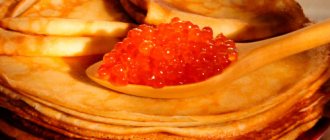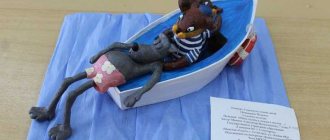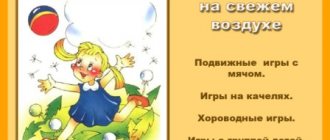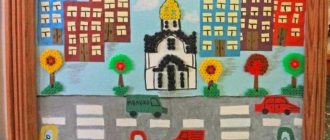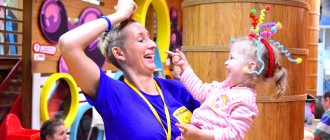The holiday that children in Rus' loved more than any other is Maslenitsa. A modern child is closer to other holidays, but you can always add one more. And if you explain to your children exactly how Maslenitsa is celebrated in Russia, then you will have the opportunity to have a great time together and at the same time get acquainted with the original Russian traditions. Most modern Russians associate the ancient holiday only with the burning of an effigy, but the celebration of Maslenitsa can be greatly diversified: with fun gifts, competitions, games, costumes and crafts.
Content:
- When does Maslenitsa start 2021 Days of Maslenitsa week
- Signs
- In kindergarten
- How to make a scarecrow for Maslenitsa
When does Maslenitsa 2021 start?
Maslenitsa is not celebrated on a specific day; the holiday falls on a different date each year. The date of Maslenitsa is calculated as follows: another 56 days are subtracted from the day of Orthodox Easter. In 2021, the date of Maslenitsa itself falls on March 14 , coinciding with the onset of the second week of calendar spring. Accordingly, Maslenitsa week begins earlier - March 8 , International Women's Day.
Days of Maslenitsa week
Every day of Maslenitsa is special. It only seems that unbridled fun continues all week - in fact, every day on the eve of a long fast is dedicated to its own rituals and traditions.
- First day (Monday) – Meeting. Day of the first pancake: on Monday the first pancake is baked and given to the poor or simply left on the windowsill. And on the day of the Meeting, women in Rus' taught their daughters to bake pancakes - this tradition can be observed in modern conditions.
- Second day (Tuesday) - Flirting. The day when young people looked closely at each other, choosing a suitable pair. Guys and girls decided on their future couple by going down the slides together and having common holiday dinners.
- The third day (Wednesday) - Gourmand. The very day from which the popular expression “to the mother-in-law for pancakes” came from. On Wednesday, sons-in-law went to treat their mother-in-law, and it was believed that the richer the mother-in-law set the table, the better she treated her daughter’s husband.
- Fourth day (Thursday) - Revelry. A day that fully lives up to its name - on Razgul in Rus', both adults and children had fun: they rode in sleds, danced in circles, played snowballs and captured snowy towns.
- Fifth day (Friday) - Mother-in-law's evening. Mothers-in-law paid a return visit to their sons-in-law; the host's duty was to treat the mother-in-law and other guests whom she wished to invite. The tradition has served and can continue to serve to strengthen the relationship between the two families.
- Sixth day (Saturday) - Sister-in-law's gatherings. The husband's sisters came to visit their daughter-in-law, who was supposed to bake pancakes for the girls. It was considered indecent to come empty-handed on this day - sisters-in-law gave their brother’s family a good gift.
- Seventh day (Sunday) - Farewell. On the last day of Maslenitsa, it is customary to ask for forgiveness from loved ones and remember the departed. But the festivities still continue: with round dances, dancing and sledding. The last symbol of farewell to Maslenitsa - the burning of an effigy - occurs on the seventh day of Maslenitsa week.
Poems about Maslenitsa
A lot of poems have been written about Maslenitsa. Unfortunately, the authors of most of them are unknown. But on the other hand, in such a rhymed and rhythmic form, getting to know the holiday is even brighter and more fun. These poems are a kind of melodies and barkers)))
* * *
Hello, annual Maslenitsa, our dear guest! Come on black horses, On painted sleighs, So that the servants will be young, They will bring us expensive gifts, And pancakes, and kalachi Swords through our window!
* * *
And we were expecting Maslenitsa, We were greeting our dear guest, We were covering the mountain with pancakes, And we were pouring butter on top. The mountain is steep like pancakes, the mountain is clear like butter, And they pour snow on the mountain, And our mothers call us home. It’s not good for us to go home, We decided to take a ride down the mountain. Oh, you Maslenitsa-crooked neck, give us a good ride.
* * *
This is Maslenitsa - a fairy who walked around houses and courtyards. So let's quickly accept her gifts! And she gives you happiness. Many victories in life, getting rid of bad weather, and letting good luck follow! We are waiting for you at Maslenitsa! We'll meet you with butter pancakes, cheese, honey, kalach and cabbage pie. Great Lent awaits us all, Eat for future use, people! Walk all week, eat up all your supplies.
* * *
Wide Maslenitsa! We boast about you, we go on roller coaster rides, we overeat on pancakes. Hey, Maslenitsa Kuroseika, give us a good ride! - Oil can, Oil can, haven’t you seen Gorasenka? - And Goraska in a red hat on a little black horse, waves her whip, and the horse dances under him.
* * *
Winter is not living its last days alone: We all see it off, We wish you a year’s rest! And now we are waiting for spring - its traces are already visible! Let it warm you and me. Happy Maslenitsa! And Happy Spring!
The history of the holiday in Rus' and the traditions of Maslenitsa
Our ancestors, the ancient Slavs, came up with the idea of celebrating Maslenitsa. Then, as now, the holiday was a symbol of farewell to winter. But Maslenitsa was celebrated in Rus' not at different times, but always at the same time - on the day of the spring equinox, after which the day becomes longer than the night. The ancient Slavs said goodbye to winter and welcomed the beginning of spring, trying in every possible way to appease the sun that rarely peeked out. Therefore, the history of the holiday is closely connected with various round shapes that reminded people of the sun: the ancient Slavs baked round pancakes and launched wooden burning wheels from the mountains.
The traditions of Maslenitsa are easy and pleasant to observe: in Rus', during the days of Maslenitsa week, it was customary to go on a visit, ride a sleigh, build ice and snow fortresses, and organize street competitions. On the last day of the holiday, a straw effigy was necessarily burned - this ritual was considered the main sign of the passing of winter.
Signs
The main sign of Maslenitsa is, of course, associated with pancakes. Each family baked as many pancakes as possible, and it was believed that if the pancakes turned out smooth and beautiful, then the family would have a successful year. Failed, burnt pancakes indicated that the year would be difficult.
It was considered a good omen to arrange matchmaking during Maslenitsa week, and ideally, to have time to have a wedding before Maslenitsa was over. The Russian people have noticed that couples who unite during the period of farewell to winter live in love and harmony.
Other folk signs for Maslenitsa:
- throwing everything unnecessary out of the house means letting in something new;
- you cannot quarrel, swear and do bad things;
- It’s a bad omen to skimp and not treat your loved ones and friends to Maslenitsa.
Signs related to weather:
- frosts on Maslenitsa - for a hot summer;
- rains - an abundance of mushrooms;
- a lot of snow during Maslenitsa week means early spring.
Christian rituals
Despite the fact that in Orthodoxy Maslenitsa is tied to Easter, the ancient holiday is not mentioned in the church calendar. The tradition of celebrating farewell to winter continued even after the adoption of Christianity in Rus', but the holiday itself has changed a little. Now Maslenitsa week precedes Lent, and at this time believers no longer eat meat - only dairy products are allowed.
Christians have preserved the ritual of burning effigy on the last day of Maslenitsa week. On this same day - Forgiveness Sunday - all Orthodox people ask each other for forgiveness for all possible insults and insults.
How they celebrated then and how they celebrate now
The traditions accompanying each day of Maslenitsa week have not survived to this day. In Rus', they strictly observed the customs of visiting mothers-in-law, sons-in-law, daughters-in-law, and choosing a beloved on a certain day of Maslenitsa. Now, of all the traditions of seeing off winter, only folk festivities have been preserved.
Modern Maslenitsa is celebrated in cities and villages: in parks, squares and on main streets. Adults and children dress up in costumes of parsleys and buffoons and participate in theatrical performances and competitions. Until now, as in former times, they organize funny folk games: tug-of-war, play snowballs, throw felt boots into the distance and, of course, burn a scarecrow.
What do they give for Maslenitsa?
Maslenitsa has always been and remains a family holiday, and gifts can only be given to the closest people. Traditional gifts for Maslenitsa, which were customary to give in Rus':
- tableware: sets of wooden utensils, butter dishes, jars for honey, caviar dishes;
- sweet treats: lollipops, buns, gingerbreads, rolls;
- decorations: scarves, ribbons, hairpins, shawls;
- costumes corresponding to the theme of the holiday;
- handmade crafts.
You can also choose a more modern gift option: ceramic dishes, refrigerator magnets, pancake makers, baking dishes, crystal, themed souvenirs.
Proverbs and sayings about Maslenitsa
The people came up with many wise proverbs and sayings about the festive Maslenitsa. Here are just some of them:
- “A pancake is not a wedge, it won’t split your stomach”
- “Maslenitsa is not all for the cat, there will be Lent too”
- “Not life, but Maslenitsa”
- “Maslenitsa – go crazy, save money”
- “At least pawn everything from yourself and celebrate Maslenitsa”
- “So that you are up to your elbows in trouble, and so that you get your fill of food”
How to celebrate Maslenitsa with your children
You can celebrate Maslenitsa with your child so that he will forever remember what the holiday is dedicated to and the customs associated with it. Before you go to the mass celebrations, tell your children about the history of Maslenitsa - the story can be supplemented with Russian folk poems and songs dedicated to Maslenitsa.
Speaking of festivities, check to see if your city hosts children’s programs dedicated to seeing off winter. If there are no events for children, perhaps you should refuse to attend a general holiday, where drunk people will probably be present.
To avoid losing your child in the crowd at mass celebrations in honor of Maslenitsa, install the “Where are my children” application. With it you can accurately track the child’s location and route, quickly contact if necessary and listen to what is happening around!
You can have a fun Maslenitsa with your child without attending a city festival: bake pancakes together, make a scarecrow figurine, play on the street and invite guests to Maslenitsa pancakes.
In kindergarten
You can introduce children to beautiful Russian rituals from a very early age - even kids will remember this interesting holiday, and Maslenitsa will not become for them just a day when they are supposed to eat pancakes.
Every day of Maslenitsa week in kindergarten can be made special by telling in an accessible way about the history and traditions of Maslenitsa. An approximate holiday plan is in the table below:
| Monday (Meeting) | Tuesday (Flirting) | Wednesday (Gourmet) | Thursday (Razgulyay) | Friday (Broad Maslenitsa) |
| Making dolls with your own hands from straw, twigs, shreds. | Making crafts in the shape of the sun, round dances. | Drawing pancakes and an exhibition of the resulting drawings. | Outdoor games, introduction to carols. | Songs, dances, round dances, pancakes. |
At school
Maslenitsa is an emotional holiday, in which there is a competitive spirit, and schoolchildren are willingly involved in organizing the farewell to winter.
With small children - primary and secondary students - it is better to celebrate the holiday within the walls of the school. How to celebrate Maslenitsa in the classroom:
- prepare the room: make room, decorate the classroom with balloons, crafts in the shape of pancakes and the sun;
- show invited parents a performance - theatrical or puppet - according to a pre-rehearsed script;
- arrange a tea party and entertainment with dancing, games and competitions.
After the holiday is over, you can play in the school yard and go down the slides.
It will be more interesting for high school students to celebrate outside of school: parents can organize a trip for adult children to a cafe that serves pancakes. After hanging out together, the guys will probably linger longer - they’ll want to go down the slides or just take a walk. Make sure your child's phone or smartwatch is charged in advance - and don't worry unnecessarily.
Haven't gotten yourself a smartwatch with GPS yet? Order them right now and have peace of mind for your child throughout the holidays - know where he is and what is happening around him! Official smartwatch store.
Maslenitsa game ideas for children
As you bid farewell to the winter, you can teach your children to play ancient, almost forgotten games. For example, in these:
- “Burners”: children stand in a “stream”, the driver’s task is to catch one of the first pair running away, the one who did not get a pair continues to drive;
- “Sun”: the driver in the center depicts the sun, the rest of the children dance around it, narrowing and expanding the circle, on the fourth round the driver says “I’m burning!” and tries to catch one of the players;
- “King of the Hill” is perhaps the most fun winter game in the fresh air: one child climbs onto a snow mound and announces that he is the king of the mountain, the task of the other children is to pull the “king” off the mountain and take his place.
Ideas for Maslenitsa competitions for children
On Maslenitsa you can play fun outdoor games with your children in the classroom or on the street:
- tug of war is the most popular Maslenitsa pastime: the guys are divided into two teams, a line is drawn in the middle between them, and the task of each team is to pull the rope towards themselves. The team whose member crossed the line loses;
- “Bathhouse” - for the game you will need small brooms, which you can make yourself during technology lessons from branches and colored paper: the task of each team is to beat colored paper decorations from their brooms onto the backs of their opponents;
- “On three legs”: children are divided into pairs, the right leg of one of the pair and the left leg of the second are tied, and in this way the participants get to the established line and return. The fastest pair wins;
- “Jump rope” - for the competition you will need two adult participants: adults twist the rope, children take turns jumping over it. The one who has jumped the most times wins;
- “Balloon fight” is a safe analogue of fist fights: children from two teams are given balloons on long handles, and they fight with these “swords” until all the balloons of one of the teams burst.
Riddles about Maslenitsa
And without fun riddles on a holiday, you can’t go anywhere. Give your children these riddles at the beginning of Maslenitsa week and set the rhythm for the whole holiday.
We say goodbye to winter, And we bake and eat pancakes, We greet spring together, What are we celebrating? (Maslenitsa)
Drive away the snowstorms from us, Take us on a carousel. Melt the cold ice, Let spring come soon! (Maslenitsa)
On this holiday, everyone strives, Not to sit at home for a long time, But everyone rushes to the fair, To watch performances, Buffoons perform, They bake delicious pancakes, Once a year there is a holiday, At the end of winter. (Maslenitsa)
This is a very tasty holiday, Gives us pancakes with caviar, And also delicious jam, What kind of holiday is this? (Maslenitsa)
Everyone around is baking pancakes, They give us plenty to eat, We burn the effigy of winter, And we invite spring to come to us. (Maslenitsa)
Fairs, smiles, songs, All the people are resting, There is no time more delicious, more wonderful, Everyone is looking forward to spring! Samovars and bagels, But most importantly, pancakes, Everyone is dancing, having fun, Come on, call it a holiday! (Maslenitsa)
My holiday Only once a year I will come to you for a week. I will bring joy to everyone and treat them to pancakes. (Maslenitsa)
On Holy Sunday, we all have to ask everyone for forgiveness and answer: ... (“God will forgive!”)
I'll meet you on Monday and play on Tuesday. On Wednesday I will treat you all. Wednesday is a treat for everyone. And on Thursday there is revelry for everyone. On Friday I’ll go to my mother-in-law, and on Saturday I’ll go to my sister-in-law. On Sunday I forgive everyone and treat them to pancakes. How can you see me off? There is a post already at the yard. (7 days of Maslenitsa)
We rest all week and treat everyone to pancakes. We bid farewell to the cold of winter, and welcome spring with warmth. (Maslenitsa)
Maslenitsa is a delight! We bake pancakes in the morning. They come with butter and jam. Well, maybe... (Caviar)!
You can’t do without it, so that the pancakes are all successful, the dough, before kneading, you need to buy it, this product is given by the cow, it glitters in the sun. It improves the taste of pancakes and is kept in the refrigerator. (Oil)
What kind of place would you say, what to call it, friends? It’s like in a fashion store, You can always buy everything, There are counters and display cases, They have sellers, Once a year they come out to sell souvenirs. (Fair)
Gourmand Wednesday is coming soon! It won't be difficult for us! We are faithful to traditions - We are going to... (Mother-in-law for pancakes)!
Riddles about pancakes
The grandmother baked napkins for the children, and the napkins made from flour turned out thin. The naughty grandchildren know that those napkins... (pancakes)
Yellow, round, fragrant and tastes so good! As soon as mom bakes it, he jumps straight into his mouth! (Crap)
They are not easy to prepare: Eggs, salt and milk, Sugar, yeast and flour - Everything is lightly beaten with a wooden round pestle into a liquid raw dough. Bake in a frying pan - Drizzle with sweet honey or sprinkle with cheese. Appetizing (Pancakes) will be delicious with butter
And we met Maslenitsa, filled the mountain with cheese, poured oil on the mountain, invited us to the wide yard. (Pancakes)
It has a round shape, yellow color is inherent in it, it warms your hands on Maslenitsa, it tastes very sweet. (Crap)
It lies in front of me, doused with sour cream! I love him, I won’t hide it! How the sun shines! I’ll only tell my mother: “I’ll eat it - not alone!” And I’ll share it with my friends. I’m the most delicious... . " (Crap)
We lived in a cramped saucepan, then we were suddenly scooped up. They poured it out, turned it over and put it on the table in a pile to stand later. They poured oil on it and sprinkled it with sugar. We taste delicious with sour cream. Fragrant... (Pancakes)
For even more riddles, see the “Children’s Riddles” section.
DIY costume for Maslenitsa
Spectacular and easy-to-make costumes for Maslenitsa - buffoon for boys and Spring for girls.
How to make a buffoon costume with your own hands:
- A colorful women's robe that fits in size is cut off from the bottom and hemmed - it turns out to be a future shirt for the buffoon.
- Slits are made on the sleeves of the shirt so that the sleeves hang down a little.
- The lower part of the costume is made from pants that are too big for the child, sewing in an elastic band at the waist.
Creating a headdress for a costume is also quite simple; watch the master class on making a hat for a buffoon with your own hands here:
How to make a Spring costume for a girl:
- Choose a flared dress in a suitable color - preferably green.
- Glue or sew paper or fabric flowers onto the dress.
- Place beads on the girl’s neck and a wreath on her head.
A beautiful wreath of artificial flowers can be made like this:
If you have no free time at all, but want to make a costume with your own hands, choose one of the simplest options:
- Spring look for a girl: over any spacious flared sundress, wear a tight, fitted sleeveless vest;
- bear costume for a boy: put a fur coat on your child turned inside out and complete the look with a bear mask;
- goat costume: attach beads and bells to the fur coat, make horns from cardboard.
You can create an image suitable for Maslenitsa even simpler: put on a boy any mask or false beard, and add themed accessories to the girl’s regular clothes, for example, a bright scarf, a sash, or beads made from bagels.
Crafts for Maslenitsa
The most popular craft for Maslenitsa is, of course, a stuffed animal. It may be difficult for small children to make a stuffed animal - with kids it is better to make a talisman doll or a sun.
How to make a scarecrow for Maslenitsa - step-by-step instructions
Nail two wooden sticks (one longer, the other shorter) to each other to form a cross - this will be the basis for the scarecrow.
- Tie the resulting figure with straw.
- Make the head from crumpled newspapers, cotton wool or dry grass, wrap the resulting round shape with a bright scarf or a suitable piece of fabric.
- Make a face for the scarecrow: mark the eyes with buttons, the mouth, nose and cheeks with red lipstick.
- Tie the finished head tightly to the craft figure.
- Dress the stuffed animal in old clothes.
A slightly more complex option for creating a scarecrow:
How to make a talisman doll - step-by-step instructions
Take a piece of fabric measuring 20 by 20 cm, place a small piece of tightly rolled cotton wool in the center of the fabric;
- Fold the fabric evenly diagonally.
- Using a long thread of the same color as the fabric, form the doll’s head: wrap a piece of cotton wool several times and secure with a knot (the main function of the doll is to protect the owner, so make the number of wraps even), do not cut the thread.
- Using your hand, form the waist and wings of the craft, bring the thread to the front of the doll, wrap the waist crosswise several times, and secure with a knot.
- You can use a thread of a different color to make a halo for the doll.
Another option for making a talisman doll:

